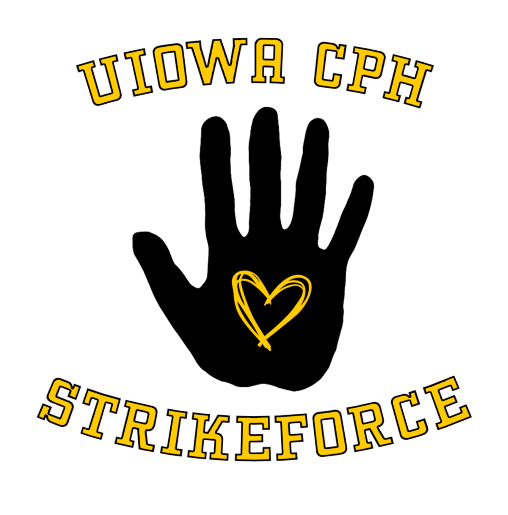Breadcrumb
6 Things to Know About the Public Health Strike Force
Published on January 6, 2023

1. What is the Strike Force?
The Public Health Strike Force is a team of student volunteers from the University of Iowa College of Public Health. The students provide support to health organizations and non-profit organizations throughout Iowa by assisting with public health-related activities, events, and emergency situations.
Organizations and agencies benefit from the engagement of skilled, enthusiastic students to assist with carrying out goals and objectives, while students build on their education and training, more effectively preparing them to enter the workforce and contribute to the strength and sustainability of Iowa’s public health infrastructure.
2. Who oversees it?
Two staff members, Bonnie Rubin (faculty sponsor) and Tricia Kitzmann (program coordinator) provide day-to-day support and direction for the Strike Force. The UI College of Public Health received funding through a contract with the Iowa Department of Health and Human Services to design and deliver a public health workforce development initiative, of which the Public Health Strike Force is one activity. The project is funded by the American Rescue Plan Act of 2021.
3. how many students are involved?
Since its formation, 47 students have participated in the Strike Force, with 39 active team members in fall 2022. The Strike Force is approved as a zero-credit course for those students who wish to have their participation recorded on their official transcript.
4. What projects have students worked on?
Team members have worked on 23 projects with nine different organizations around the state as of fall 2022. Students have:
- Received and processed COVID-19 test kits at the State Hygienic Laboratory and assembled sample collection kits for distribution when cases of COVID-19 surged in early 2022.
- Helped Dickinson County Health Department assess how its seasonal tourism population impacts public health strategies through literature and best practice reviews focusing on dental health, transportation, and mental health to be used for the community health assessment.
- Conducted door-to-door Community Assessment for Public Health Emergency Response (CASPER) surveys in Johnson County.
- Collected lake water samples and learned the importance of integrating public and environmental health at the Iowa Lakeside Laboratory.
- Gathered survey data for the Fayette County Community Needs Assessment during the Fayette County Fair.
- Assisted community members with filling out the Johnson County Community Health Assessment.
- Completed Stop the Bleed training with plans for CPR and Violent Incident Survival Training in the future.
5. How do students join the Strike Force?
Students must be in good academic standing and fill out an application. They are required to complete training consisting of three incident command courses and a HIPAA compliance course. Once they have finished the training, students receive a Strike Force T-shirt and business cards to help identify their role. They are matched with projects based on interests and availability.
6. How does an organization request help from the student Strike Force?
Organizations and agencies can involve public health students in a variety of projects. Students may assist with large-scale campaigns, assessments, or activities or respond to emergent situations. More information and a request form are available on the web.
“I think it’s a great opportunity when we can give students hands-on experience and some of the training that’s going to be required when they go out into the workforce, outside of the things that they learn through their academics.”
Tricia Kitzmann, program coordinator
“The Strike Force is an opportunity for College of Public Health students to get real-life, hands-on experience, especially in emergency or large event activities. We’re designed to assist public health departments or any sort of public health-related organization when they need more hands, or when there’s an event that needs a lot more people to accomplish what they want to do. We’re there to help with both emergent and non-emergent events.”
Bonnie Rubin, faculty sponsor
This article originally appeared in the Fall 2022 issue of InSight magazine